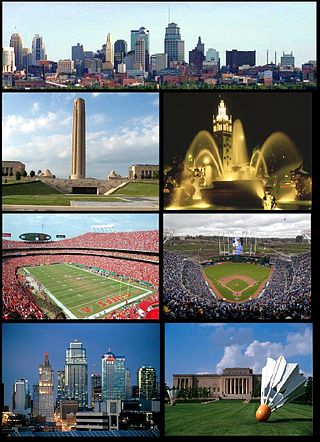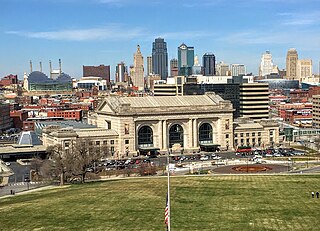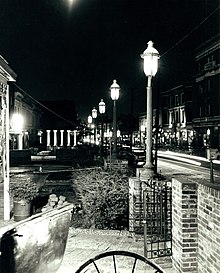
Kansas City, Missouri is the largest city in the U.S. state of Missouri by population and area. Most of the city lies within Jackson County, with portions spilling into Clay, Platte, and Cass counties. It is the central city of the Kansas City metropolitan area, which straddles the Missouri–Kansas state line and has a population of 2,392,035. As of the 2020 census, the city had a population of 508,090, making it the 37th most-populous city in the United States, as well as the sixth-most populous city in the Midwest. Kansas City was founded in the 1830s as a port on the Missouri River at its confluence with the Kansas River from the west. On June 1, 1850, the town of Kansas was incorporated; shortly after came the establishment of the Kansas Territory. Confusion between the two ensued, and the name Kansas City was assigned to distinguish them soon after.

St. Louis is an independent city in the U.S. state of Missouri. It is located near the confluence of the Mississippi and the Missouri rivers. In 2020, the city proper had a population of 301,578, while its bi-state metropolitan area, which extends into Illinois, had an estimated population of over 2.8 million. It is the largest metropolitan area in Missouri and the second largest in Illinois. The city's combined statistical area (CSA) is the 20th largest in the United States.

Music of Missouri has a storied musical history. Missouri has had major developments in several popular music genres and has been the birthplace or career origin of many musicians. St. Louis was an important venue for early blues, jazz, country, and bluegrass. Kansas City has had famous performers such as Charlie Parker, Count Basie, Lester Young, and the distinct style of Kansas City jazz. Ragtime made influence in the city of Sedalia, Missouri, due to Scott Joplin and his publisher John Stark, and through Missouri native James Scott.

The Kansas City metropolitan area is a bi-state metropolitan area anchored by Kansas City, Missouri. Its 14 counties straddle the border between the U.S. states of Missouri and Kansas. With 8,472 square miles (21,940 km2) and a population of more than 2.2 million people, it is the second-largest metropolitan area centered in Missouri and is the largest metropolitan area in Kansas, though Wichita is the largest metropolitan area centered in Kansas. Alongside Kansas City, Missouri, these are the suburbs with populations above 100,000: Overland Park, Kansas; Kansas City, Kansas; Olathe, Kansas; Independence, Missouri; and Lee's Summit, Missouri.
KETC is a PBS member television station in St. Louis, Missouri, United States, owned by St. Louis Regional Public Media. The station's studios are located at the Dana Brown Communications Center on Olive Street in St. Louis' Grand Center neighborhood, and its transmitter is located in South St. Louis County.

Fran Landesman was an American lyricist and poet. She grew up in New York City and lived for years in St. Louis, Missouri, where her husband Jay Landesman operated the Crystal Palace nightclub. One of her best-known songs is "Spring Can Really Hang You up the Most".

Downtown Kansas City is the central business district (CBD) of Kansas City, Missouri and the Kansas City metropolitan area which contains 3.8% of the area's employment. It is between the Missouri River in the north, to 31st Street in the south; and from the Kansas–Missouri state line eastward to Bruce R. Watkins Drive as defined by the Downtown Council of Kansas City; the 2010 Greater Downtown Area Plan formulated by the City of Kansas City defines the Greater Downtown Area to be the city limits of North Kansas City and Missouri to the north, the Kansas–Missouri state line to the west, 31st Street to the south and Woodland Avenue to the east. However, the definition used by the Downtown Council is the most commonly accepted.

The Grand Center Arts District is located in the Midtown St. Louis Historic District north of the Saint Louis University campus. Referred to colloquially as Grand Center, the neighborhood's formal name is Covenant Blu Grand Center. The neighborhood's is a member of the Global Cultural Districts Network.

The Fox Theatre, a former movie palace, is a performing arts center located at 527 N. Grand Blvd. in St. Louis, Missouri, United States. Also known as "The Fabulous Fox", it is situated in the arts district of the Grand Center area in Midtown St. Louis, one block north of Saint Louis University. It opened in 1929 and was completely restored in 1982.

Lafayette Square is a neighborhood in St. Louis, Missouri, which is bounded on the north by Chouteau Avenue, on the south by Interstate 44, on the east by Truman Parkway, and on the west by South Jefferson Avenue. It surrounds Lafayette Park, which is the city's oldest public park — created by local ordinance in 1836.
The culture of St. Louis, Missouri includes a variety of attractions located within the city of St. Louis, Missouri, and in surrounding communities in Greater St. Louis, such as local museums, attractions, music, performing arts venues, and places of worship.

Rocco Landesman is a long-time Broadway theatre producer. He served as chairman of the National Endowment for the Arts from August 2009 to December 2012. He is a part owner of Jujamcyn Theaters.

Midtown is a neighborhood in St. Louis, Missouri. It is located 3 miles (4.8 km) west of the city riverfront at the intersection of Grand and Lindell Boulevards. It is home to the campus of Saint Louis University and the Grand Center Arts District.

President is a steamboat that currently lies dismantled in Effingham, Illinois, United States. Originally named Cincinnati, it was built in 1924 and is the only remaining "Western Rivers" style sidewheel river excursion steamboat in the United States. She was listed on the National Register of Historic Places and declared a National Historic Landmark in 1989, although these designations were revoked in 2011. Her home ports have been Cincinnati, Ohio; New Orleans, Louisiana; Vicksburg, Mississippi; St. Louis, Missouri; and Davenport, Iowa.
Singleton Palmer was an American jazz multi-instrumentalist and bandleader of the Dixieland Six.

Westport Plaza is a 42-acre (170,000 m2), commercial development, resort, and entertainment center located in Maryland Heights, Missouri. Westport was built by a prominent St. Louis developer, Thomas J. White, and opened in 1973. Westport since has grown to over 700,000 square feet (65,000 m2) of office buildings, restaurants, entertainment venues, and hotels. The property was purchased jointly in 2007 by real estate company Golub & Co. and Boston-based Intercontinental Real Estate Corp. In 2012, Westport Plaza was purchased by Lodging Hospitality Management. The entertainment complex hosts many popular events over the year including the St. Louis Beer and Brat Festival, lunchtime concerts, "Parties at the Plaza" events, jazz concerts and Archon 34. The plaza underwent a major renovation in 2023-2024 with the construction of an open green space and large television as part of Rawlings (company) building The Rawlings Experience at the site.
Irving Ned "Jay" Landesman was an American publisher, nightclub owner, writer, and long-time expatriate resident in London, England.
The following is a timeline of the history of the city of St. Louis, Missouri, United States.
The Nervous Set is a 1959 Broadway musical written by Jay Landesman and Theodore J. Flicker which centers on the Beat Generation. It tells the story of a wealthy publisher and his wife from a Connecticut suburb exploring the Greenwich Village of New York City as they navigate their dysfunctional marriage.
Ameristar Casino Resort Spa St. Charles is a riverboat casino located on the Missouri River in St. Charles, Missouri, a northwestern suburb of St. Louis. It is one of several casinos in the greater St. Louis market. It is currently owned by Boyd Gaming. Ameristar attracts over 5.5 million visitors a year and is one of the most visited tourist attractions in Missouri.













